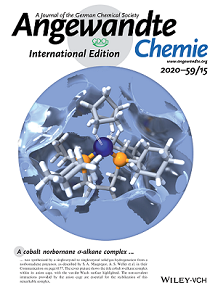Synthesis of an ‘impossible’ complex
A research team from the Department of Chemistry has synthesised a fascinating new cobalt complex previously considered too reactive to make.

Professor Andrew Weller and his team, led by PhD student Tim Boyd, have synthesised an example of a highly unstable, paramagnetic, cobalt(I) alkane complex with a unique mode of stabilisation.
They achieved this using a single-crystal to single-crystal conversion in the solid phase driven by simple addition of hydrogen, which allows a stable precursor to be converted into the desired complex in the solid-state. This approach is needed because the weakness of the metal-alkane bond means such species would not survive using traditional solution techniques.
A key aspect of the stabilisation in the solid-state comes from a surrounding anion microenvironment, which forms a protective cage around the highly-reactive metal cation. This is shown in the cover art highlighted in Angewandte Chemie.
Such metal-alkane complexes are key intermediates in C−H activation reactions: processes that turn simple hydrocarbons, which currently are just burned for heat, into valuable feedstocks in the chemical's supply chain. Isolating and understanding the properties of such species can therefore lead to improved, lower energy and more selective methods in synthesis and catalysis.
This research is published in Angewandte Chemie, with the cover art prepared by Dr Karl Harrison (University of Oxford). The work was funded, in part, by the EPSRC and SCG Chemicals.